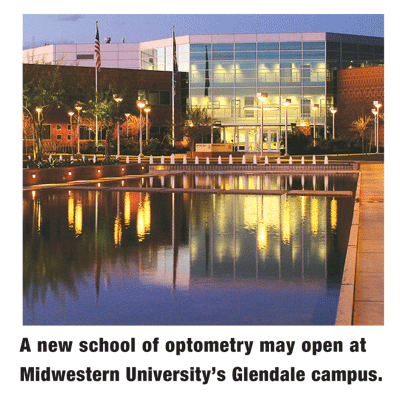 Another new college of optometry is on the drawing boardthis time, just outside of
Another new college of optometry is on the drawing boardthis time, just outside of
First, the universitys board of trustees must approve a proposal, which is slated for its review in September. If approved by the board, the universitys next step is to obtain licensing approval from the state board of postsecondary education. If that, too, is approved, only then can Midwestern apply to the Accreditation Council on Optometric Education. Obtaining this final approval will allow the university to recruit applicants to the program, Dr. Lee says.
Midwestern
For example, the pharmacy students and osteopathic medicine students take pharmacology courses together. In addition to ensuring that pharmacy students know just as much about the subject area as the osteopathic medicine students, we think that this fosters improved working relationships among our graduating students, Dr. Lee says. The osteopathic medicine graduates will know that the pharmacy graduates studied in the same classroom that they did and presumably know just as much about the topic as they do.
Also, first-year students in all academic programs take an interdisciplinary core course together in which students learn about the important roles played by various health professionals in the care of patients.
The university strongly believes that the health-care teamcomposed of members from many different disciplinescan provide higher-quality services and minimize management errors than health professionals who work in their own discipline-specific silo, Dr. Lee says. Thus, our core course is the first step in educating our students to respect others in the health-care team and recognize the value of the each member of the team.
But, is another college of optometry necessary? I am vehemently opposed, says one O.D.s post on www.ODwire.org. Every O.D. I have ever spoken to is wanting more patients. I would like to see two or three of the existing schools close.
Says another O.D.s post: The trend seems to be more schools, more graduates, and [that leads to] lower salaries and [fewer] job opportunities.
There is no manpower shortage of optometrists, Dr. Lee acknowledges, but the employment outlook for O.D.s is still positive due to several factors:
The rising need for vision care among baby boomers.
Longer life expectancy for all Americans, which increases the development of age-related eye disease.
Increasing numbers of female optometrists, who generally practice fewer full-time years than male optometrists.
An increasing number of retiring optometrists.
A shortage of O.D.s in rural areas, despite an excess of optometrists in metropolitan areas.
There is a need for an optometry school in
No schools of optometry exist in the desert southwest. The closest colleges of optometry are in
In terms of population,
Details of Midwesterns college of optometry have yet to be ironed out, Dr. Lee says. If the college is approved, the size of the entering class would probably be small, perhaps 30 to 50 students, she says. The university has yet to determine the curriculum or cost of tuition.
The Arizona Optometric Association had no official comment at this time.

